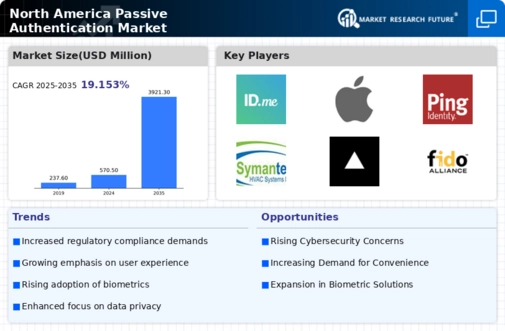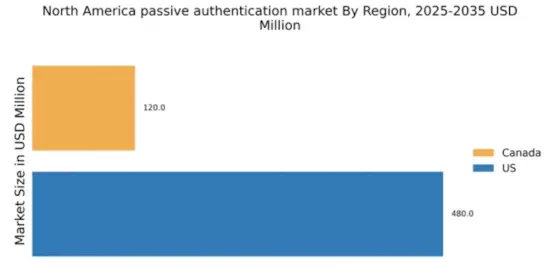Increased Cybersecurity Awareness
There is a notable increase in cybersecurity awareness among organizations in North America, which is driving the growth of the passive authentication market. As cyber threats become more sophisticated, businesses are recognizing the importance of implementing robust security measures. This heightened awareness is leading to greater investment in passive authentication technologies, which offer a more secure and user-friendly approach to identity verification. The passive authentication market is thus experiencing a surge in demand as organizations prioritize cybersecurity in their operational strategies. This trend is likely to continue, as the need for effective security solutions remains a top concern for businesses.
Shift Towards Remote Work Solutions
The shift towards remote work has created a new landscape for security challenges, thereby influencing the passive authentication market. As more organizations adopt flexible work arrangements, the need for secure remote access has become paramount. This trend is particularly relevant in North America, where businesses are seeking solutions that can provide secure authentication for remote employees. The passive authentication market is responding to this demand by offering technologies that facilitate secure access without the need for constant user intervention. As remote work continues to be a prevalent model, the adoption of passive authentication solutions is expected to grow, further driving market expansion.
Growing Demand for Seamless Security
The increasing need for seamless security solutions is a primary driver in the passive authentication market. Organizations in North America are prioritizing user experience while ensuring robust security measures. This trend is evident as businesses seek to minimize friction during user authentication processes. According to recent data, the market for passive authentication solutions is projected to grow at a CAGR of 15% over the next five years. This growth is fueled by the rising number of cyber threats, prompting companies to adopt more sophisticated security measures. The passive authentication market is thus witnessing a shift towards solutions that provide security without compromising user convenience, making it a critical area of focus for businesses.
Advancements in Technology Infrastructure
The rapid advancements in technology infrastructure are significantly impacting the passive authentication market. With the proliferation of cloud computing and IoT devices, organizations are increasingly adopting solutions that can integrate seamlessly with existing systems. This trend is particularly pronounced in North America, where businesses are investing heavily in digital transformation initiatives. The passive authentication market is benefiting from these advancements, as companies seek solutions that can provide secure access across multiple platforms and devices. As organizations continue to modernize their IT infrastructure, the demand for innovative passive authentication solutions is expected to increase, driving market growth.
Regulatory Compliance and Data Protection
Regulatory compliance is becoming increasingly stringent in North America, driving the demand for passive authentication solutions. Organizations are required to adhere to various data protection regulations, such as the California Consumer Privacy Act (CCPA) and the General Data Protection Regulation (GDPR). These regulations necessitate the implementation of advanced security measures to protect sensitive user data. The passive authentication market is responding to this need by offering solutions that not only enhance security but also ensure compliance with legal requirements. As companies face potential fines and reputational damage from non-compliance, the adoption of passive authentication technologies is likely to rise, contributing to market growth.

















